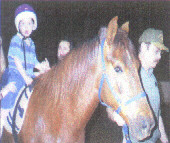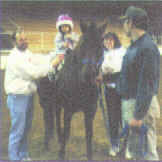 Therapeutic horseback riding uses horses and horse-related activities to
give people with various disabilities the opportunity to learn new skills
and to achieve cognitive, behavioral, psychological, and physical goals.
Each rider has individual goals and strengths so each rider's learning
program is tailored to meet his or her needs. At MVTH, we incorporate
goals from school-based Individualized Education Plans (IEPs),
Individualized Family Service Plans (IFSPs), and the rider's personal
goals. For example, if a rider needed to learn colors, we could place
signs of different colors around the arena and instruct the rider to find
the desired color. By using the horse as a teaching tool, student
motivation is heightened . We have also found that therapeutic riding can
improve the rider's motivation outside the arena. The occupational
therapist of one of our riders reported that the rider was much more
motivated to work on arm movement during her OT treatment because she
wanted to have better control of her horse.
Therapeutic horseback riding uses horses and horse-related activities to
give people with various disabilities the opportunity to learn new skills
and to achieve cognitive, behavioral, psychological, and physical goals.
Each rider has individual goals and strengths so each rider's learning
program is tailored to meet his or her needs. At MVTH, we incorporate
goals from school-based Individualized Education Plans (IEPs),
Individualized Family Service Plans (IFSPs), and the rider's personal
goals. For example, if a rider needed to learn colors, we could place
signs of different colors around the arena and instruct the rider to find
the desired color. By using the horse as a teaching tool, student
motivation is heightened . We have also found that therapeutic riding can
improve the rider's motivation outside the arena. The occupational
therapist of one of our riders reported that the rider was much more
motivated to work on arm movement during her OT treatment because she
wanted to have better control of her horse.
 Therapeutic horseback riding consists of up to three volunteers assisting
a rider who has a disability as (s)he learns proper horsemanship
techniques to the best of his/her ability. Typically one volunteer leads
the horse while two others "sidewalk". This means that they walk along
side the rider providing assistance with balance and positioning as
needed. As riders become more proficient, they require less assistance.
Some riders eventually become independent. Therapeutic riding is no pony
ride! The volunteers' purpose is to ensure the safety of the rider but
they must allow the rider be in control to the highest degree possible
within the bounds of safety. An instructor conducts the lesson directing
each rider through various tasks and games to facilitate the attainment of
individuals goals. Riders may ride with or without a saddle; they may ride
backward or forward or they may lie across the horse; they may be involved
with grooming; and they may participate in driving a horse-drawn cart if
severe physical disabilities prevent the individual from riding safely
with even the highest amount of assistance. The primary concern is to
provide a safe learning environment.
Therapeutic horseback riding consists of up to three volunteers assisting
a rider who has a disability as (s)he learns proper horsemanship
techniques to the best of his/her ability. Typically one volunteer leads
the horse while two others "sidewalk". This means that they walk along
side the rider providing assistance with balance and positioning as
needed. As riders become more proficient, they require less assistance.
Some riders eventually become independent. Therapeutic riding is no pony
ride! The volunteers' purpose is to ensure the safety of the rider but
they must allow the rider be in control to the highest degree possible
within the bounds of safety. An instructor conducts the lesson directing
each rider through various tasks and games to facilitate the attainment of
individuals goals. Riders may ride with or without a saddle; they may ride
backward or forward or they may lie across the horse; they may be involved
with grooming; and they may participate in driving a horse-drawn cart if
severe physical disabilities prevent the individual from riding safely
with even the highest amount of assistance. The primary concern is to
provide a safe learning environment.
This page was last modified on March 24, 2002.
This web page was created by Larry Loos, Larry@showme.net